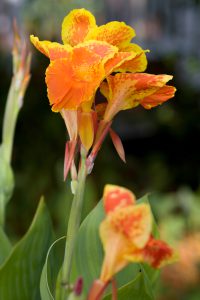
Perhaps one of the most popular and successful perennial flowers adapted to our hot and wet Florida climate are the canna lilies. They not only have large flowers, some actually have colorful foliage. From a short end of just under two feet to over six feet tall, cannas can make a great versatile and sustainable impact in your yard. Canna are in fact Florida-Friendly Landscaping™ approved as well!
Cannas are tropical to sub-tropical perennials that have foliage similar to a banana. As mentioned earlier, their perennial nature provides colorful foliage ranging from green to greenish blue and from purplish to white striped. Add flowers that come in ivory, yellow, rose, salmon, crimson and red, and you have a plant that will improve the looks of any landscape. Cannas are often used in borders or mass planted in round or square beds for a formal look. Cannas will benefit from rich soil so consider adding several inches of well-rotted manure as you prepare the soil before planting. They also like moist soil, even low-lying, bog-like conditions, so consider the location when planting. Select a site that is full sun for best growth; some partial shade can be tolerated, however. Cannas generally come as potted plants or bare-root rhizomes (swollen underground stems) that are planted one to two feet apart depending on the ultimate size of the specific cultivar. Start fertilizing cannas in the spring. This supplemental feeding plus adequate water will help guarantee optimum blooming. Careful removal of the spent flowers will help promote subsequent flowering throughout the season. Some cultivars are self-cleaning, making the removal of old flowers unnecessary.
Also consider growing cannas in pots. Four-to-five-gallon plastic pots filled with rich soil makes an ideal setting for cannas. Generally, less fertilizer and water is used, and exposure to soil-dwelling insects and nematodes is greatly reduced. Potted cannas can be placed wherever you need them to brighten up a dull spot. They can actually be buried up to their rims to blend in with the landscape.
Besides dividing rhizomes, you can also grow cannas from seed – I have successfully done this. As cannas seeds have a tough seed coat, soaking them in warm water for twenty-four hours helps speed and increase germination. If the seeds are started early enough, you can actually get flowering-sized plants this summer.
Beds of cannas quickly get overcrowded and will need rejuvenation each year. Rejuvenation will allow for a clean-up of the bed and resetting of the best rhizomes. Dig up the clumps and clean out the old rhizomes. Look for vigorous rhizomes which contain viable eyes (sprouts). Clean the selected rhizomes and replant in the landscape or pots at once.
Selecting which cannas varieties to grow is a wide-open task depending on your need and aesthetic tastes. Keep in mind that there are two different kinds of flower types. Flowers arranged close together are called “gladiolus flowering” cannas. Loosely arranged, with narrow petals, the other type of cannas is classified as “orchid flowering”. Cannas are further classified into groups in consideration of their heights. Very tall growing cannas are sometimes called giant cannas and are at least four feet tall. The next group of cannas are labeled as low growing and range from twenty-four to about thirty-six inches. The smallest group of cannas is called dwarfs and will grow to only about eighteen inches tall. Select, mix and match your cannas as appropriate.
Cannas rhizomes are available in most garden centers right now. Seeds may have to be obtained through mail-order catalogs or on-line. For more information on all types of flowering perennials, or to ask a question, please visit https://www.facebook.com/CharlotteMGLifeline/ . Ralph E. Mitchell is the Director/Horticulture Agent for the UF/IFAS Charlotte County Extension Service. He can be reached at 941-764-4344 or ralph.mitchell@charlottecountyfl.gov.
Resources:
Tjia, B. & Black, R. J. (2003) Cannas for the Florida Landscape. The University of Florida Extension Service, IFAS.
The Florida-Friendly Landscaping™ Guide to Plant Selection & Landscape Design (2010) The University of Florida Extension Service, IFAS.
UF/IFAS Gardening Solutions – Cannas. The University of Florida Extension Service, IFAS.
Landre, C. (2022) Canna Lilies. South-Florida-Plant-Guide.com
 3
3
